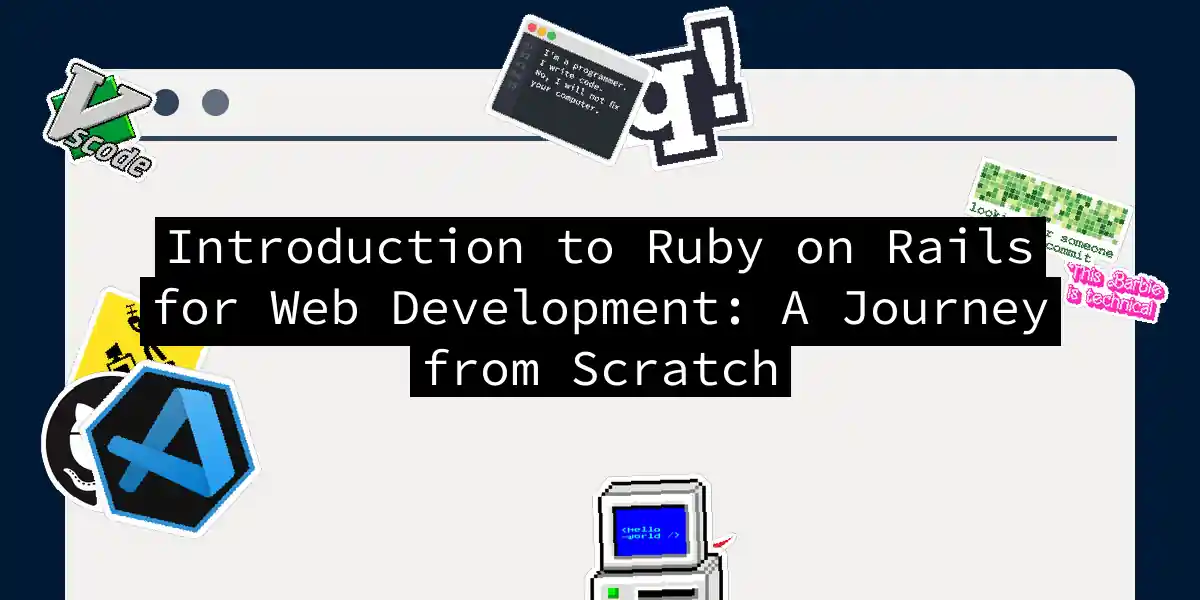Welcome to the World of Ruby on Rails
If you’re reading this, you’re probably eager to dive into the world of web development, and what better way to do that than with Ruby on Rails? This framework, created by David Heinemeier Hansson, is known for its elegance, power, and the sheer joy it brings to developers. So, buckle up and let’s embark on this journey together.
What is Ruby on Rails?
Ruby on Rails, often simply called Rails, is a web application framework written in the Ruby programming language. It’s designed to make web development easier by making assumptions about what every developer needs to get started. This “opinionated software” encourages a specific way of doing things, which can significantly boost your productivity if you learn “The Rails Way”[2].
Setting Up Your Development Environment
Before we dive into the fun stuff, let’s get our development environment set up.
Installing Ruby and Rails
To start, you’ll need to install Ruby and Rails. Here are the steps:
Install Ruby: You can use a version manager like RVM (Ruby Version Manager) or rbenv to install Ruby. For example, with RVM:
rvm install ruby-3.1.2 rvm use ruby-3.1.2Install Rails: Once Ruby is installed, you can install Rails using gem:
gem install railsCreate a New Rails Application: Now, let’s create a new Rails application. Open your terminal and run:
rails new my_app cd my_app
Starting the Web Server
To see your application in action, you need to start the web server. Run the following command in your application directory:
bin/rails server
If you’re on Windows, you might need to use:
ruby bin\rails server
This will start your server, and you can access your application at http://localhost:3000[2].
Understanding the MVC Pattern
Rails follows the Model-View-Controller (MVC) pattern, which is a fundamental concept in web development.
Models
Models represent the data and business logic of your application. They interact with the database and define the structure of your data.
Controllers
Controllers handle incoming requests, interact with models to retrieve or update data, and then render the appropriate view.
Views
Views are responsible for displaying the data to the user. They are typically written in HTML and ERB (Embedded Ruby).
Here’s a simple sequence diagram to illustrate the MVC flow:
Routing in Rails
Routing in Rails maps URLs to controller actions. Here’s an example of how you can add a route to your config/routes.rb file:
Rails.application.routes.draw do
get "/articles", to: "articles#index"
root "articles#index"
end
This sets up a route for /articles and makes the root path of your application point to the index action of the ArticlesController[2].
Creating Your First Controller and View
Let’s create a simple “Hello, Rails!” application.
Adding a Route
First, add a route to your config/routes.rb file:
Rails.application.routes.draw do
get "/hello", to: "hello#index"
end
Creating the Controller
Generate a new controller:
bin/rails generate controller Hello index
Creating the View
Edit the app/views/hello/index.html.erb file to display your message:
<h1>Hello, Rails!</h1>
Now, when you visit http://localhost:3000/hello, you’ll see your “Hello, Rails!” message.
Test-Driven Development (TDD)
TDD is a crucial part of Rails development. It ensures your code is robust and maintainable. Here’s a brief example using RSpec:
Installing RSpec
Add RSpec to your Gemfile:
group :development, :test do
gem 'rspec-rails', '~> 5.0'
end
Then run:
bundle install
bin/rails generate rspec:install
Writing a Test
Create a test for your HelloController:
# spec/controllers/hello_controller_spec.rb
require 'rails_helper'
RSpec.describe HelloController, type: :controller do
describe 'GET #index' do
it 'returns a success response' do
get :index
expect(response).to be_successful
end
it 'renders the index template' do
get :index
expect(response).to render_template('index')
end
end
end
Run your tests with:
bin/rspec
Deployment with Heroku
Once you’ve built your application, it’s time to deploy it. Heroku is a popular choice for deploying Rails apps.
Setting Up Heroku
- Install the Heroku CLI: Download and install the Heroku CLI from the Heroku website.
- Create a Heroku App: Run the following command in your application directory:
heroku create - Push Your Code: Push your code to Heroku:
git push heroku main - Migrate the Database: Run the database migrations on Heroku:
heroku run rails db:migrate
Now, your application is live on Heroku!
Conclusion
Ruby on Rails is a powerful and elegant framework that makes web development a joy. From setting up your environment to deploying your application, Rails provides a robust set of tools and best practices to help you build high-quality web applications.
Remember, practice makes perfect. Keep building, testing, and deploying, and you’ll soon become a Rails master.
Here’s a flowchart to summarize the steps we’ve covered:
Happy coding, and see you in the next adventure
